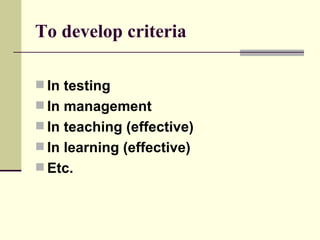Delphi
- 1. Delphi A versatile methodology for conducting qualitative research
- 2. Definition It is a method for the "systematic solicitation and collation of judgments on a particular topic through a set of carefully designed sequential questionnaires interspersed with summarized information and feedback of opinions derived from earlier responses" (Delbecq, Van de Ven, & Gustafson, 1975, p. 10).
- 3. Process Develop a set of questionnaires. Typically three or four questionnaires mailed to the respondents are used to obtain the required data. 2. Identify, select, and contact the respondents. Frequently a nominating process is used whereby key individuals may nominate someone with the expertise to participate in the study. 3. Select a sample size. Thirty is frequently used as an upper bound due to limited numbers of new ideas, three or four people is probably too few, and usually between ten and twenty people is reasonable.
- 4. Process Develop the first questionnaire, mail it to the respondents, and obtain the responses. For example, the questionnaire could contain ten to fifteen open-ended questions. 5. Analyze the data. Responses to questions could be grouped or categorized by frequency or other criteria.
- 5. Process Develop the second questionnaire, mail it to the respondents, and obtain the responses. This questionnaire is developed from the first questionnaire responses. It might request the respondents to review responses that have been categorized and rate them according to a scale. 7. Analyze the data. This analysis should tally the votes for each of the responses; determine various statistics such as mean, mode, standard deviation, and so on for each response; and finally, summarize additional responses for the next round.
- 6. Process Develop the third questionnaire, mail it to the respondents, and obtain the responses. Provide the respondents with the outcome of the second round and ask them if they would like to reconsider their own second round responses. Analyze the data. Determine if there is a consensus. 10. Complete the final report
- 7. Applications of Delphi The Delphi method was designed for the technological forecasting of future events. Today, a review of the literature indicates that it is considered a reliable qualitative research method with potential for use in problem solving, decision making, and group consensus reaching in a wide variety of areas.
- 8. Delphi applications in HE To develop goals and objectives To improve curriculum To assist in strategic planning, and To develop criteria
- 9. To develop goals and objectives To determine faculty perceptions of institutional needs and goals, and To develop consensus on the role expectations of department chairs, leading to a reduction of ambiguity and conflict
- 10. To improve curriculum Performing curriculum revision based on the findings of Delphi studies Ms Razmjou’s thesis: Developing some guidelines to improve BA translation curriculum
- 11. To develop criteria In testing In management In teaching (effective) In learning (effective) Etc.
- 12. Developing some guidelines to revise BA Translation Curriculum Sample: 30 experts in the fields of linguistics, TEFL, and Translation from Shiraz, Tehran, and Tabriz Questionnaires: Two of them with the first including 3 open-ended questions and the second 55 likert-scale items based on the responses from the first
- 13. The first questionnaire To improve translation students’ knowledge, skills, and abilities what courses do you suggest? What strategies should we use in order to implement the courses successfully? 3. What do you suggest to enhance translation students’ motivation?
- 14. The second questionnaire Based on the responses from the first questionnaire, the second questionnaire was developed using likert-scale. The questionnaire included 55 items in three categories: Course content and skills (25 items) Strategies (12 items) Ways to increase motivation (18 items)
- 15. Results Analysis of the data indicated that the respondents reached a consensus on 47 items out of 55 items. Accordingly, suggestions in the form of some guidelines were developed for a revision in the BA translation curriculum
- 16. Advantages of Delphi Method Group decision-making using anonymous controlled-feedback procedures are often more accurate than face-to-face discussions. 2. Opinions using the Delphi method can be received from a group of experts who may be geographically separated from one another.
- 17. Advantages of Delphi Method 3. Consensus reached by the group reflects reasoned opinions because the Delphi process forces group members to logically consider the problem under study and to provide written responses. 4. Group responses can be described statistically.
















